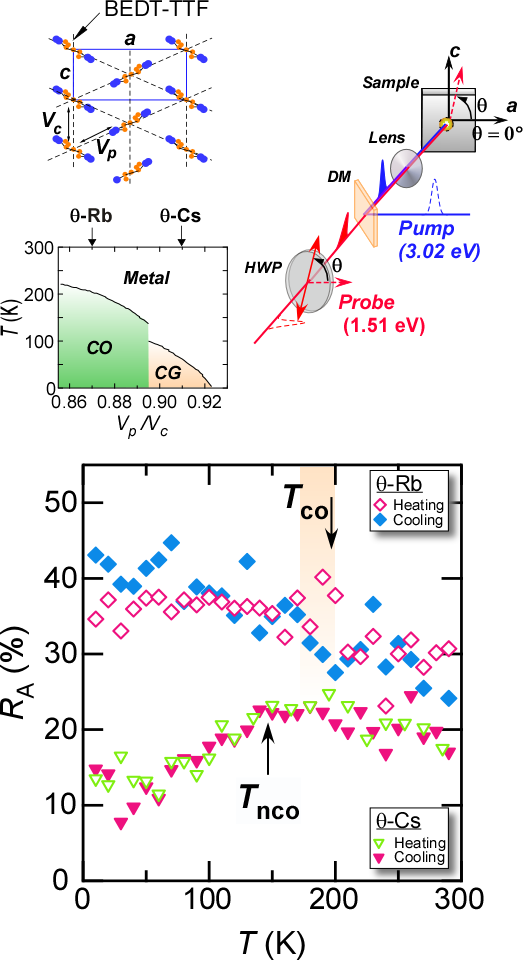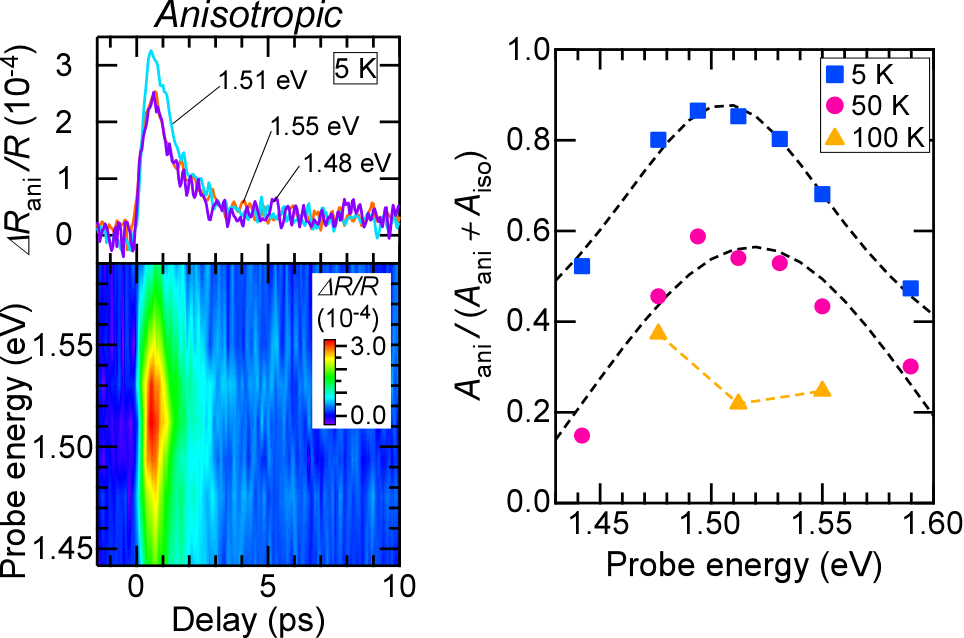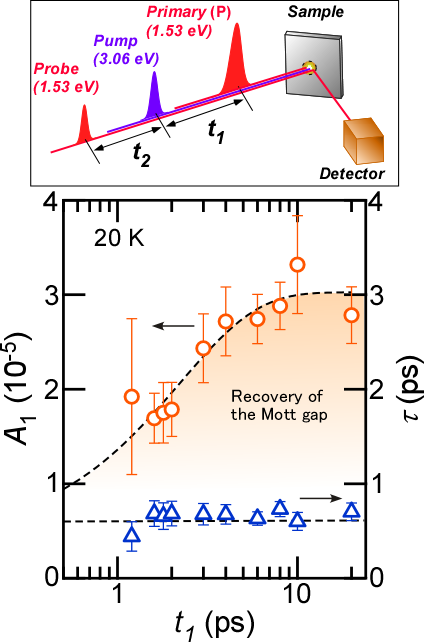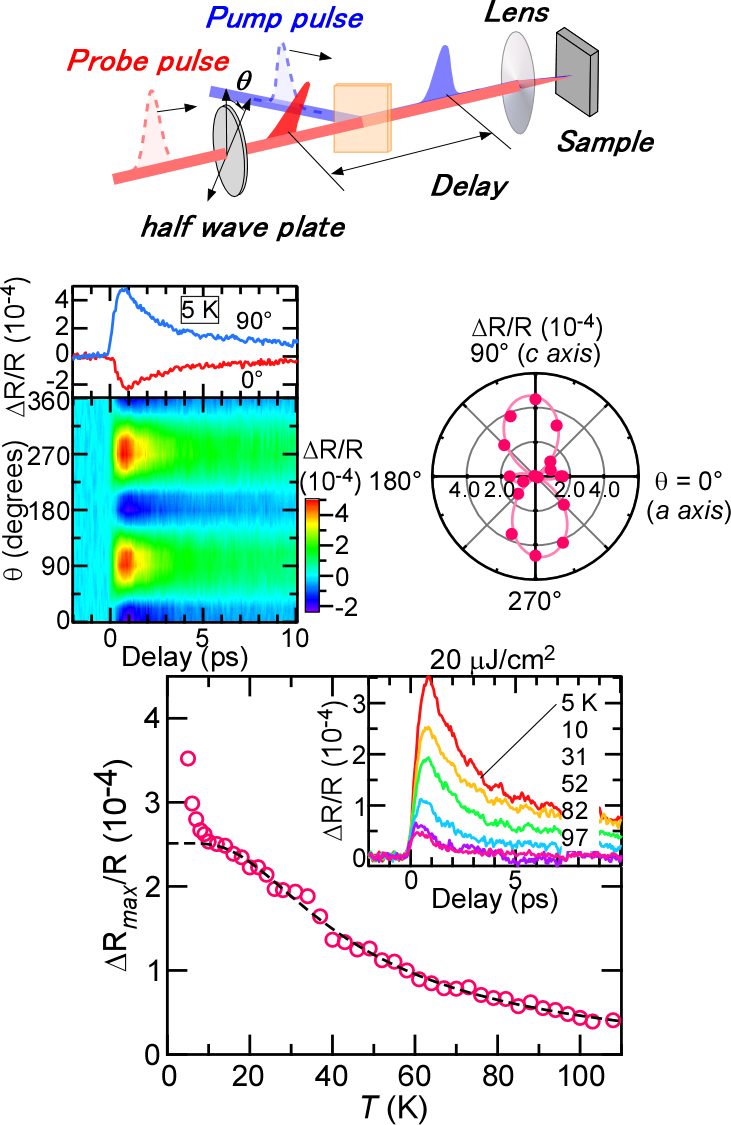Reserch Themes
Investigation of electronic properties by optical time-resolved spectroscopy
Observation of change in electronic state due to molecular displacement by optical pulse measurement
The organic conductor alpha-ET2I3 has a peculiar band structure, and it has been suggested that a Dirac electron appears under pressure, which has been the subject of much theoretical and experimental research. On the other hand, however, it is still unclear whether the substitution of STF or BETS molecules for ET molecules induces a change in electronic and magnetic properties or not, and the molecular substitution effect has not yet been clarified.
To systematically investigate the molecular substitution effects, we have performed pump-probe time-resolved spectroscopy on each salts to investigate the electronic states realized at low temperatures.
The figures below show the temperature dependence of resistivity and photo-induced carrier dynamics for the three salts. For all salts, we found that at the temperature at which the resistivity increases, there is a change in the dynamics, but there are differences in the relaxation time and polarization properties. Detailed analysis suggests charge ordering in alpha-ET2I3, short-range charge ordering in alpha-STF2I3, and topological insulating properties in alpha-BETS2I3.
Condensed Matter 8, 88 (2023)
J. Phys. Soc. Jpn. 92, 094703 (2023)

Investigation of electronic properties by optical time-resolved spectroscopy
Uniform and non-uniform charge ordering observed by optical pulse measurements
A glass is a state in which molecular motion in a liquid slows down with decreasing temperature and the molecules are frozen in an irregular arrangement. In recent years, it has been discovered that electrons in solids become glassy (charge glass) in organic conductors. However, there are few experimental techniques that can detect this charge glassy state, and it is still unclear in what configuration the electrons are actually frozen.
Therefore, time-resolved spectroscopy was performed to investigate properties of the charge glass in terms of photo-induced carrier dynamics.
The right figures show the results of the measurements, showing the temperature dependences of fruction (RA) of polarization-dependent dynamics component in theta-(BEDT-TTF)2RbZn(SCN)4(theta-Rb), which exhibits charge ordering (crystal) with electrons in regular order, and in theta-(BEDT-TTF)2CsZn(SCN)4(theta-Cs), which exhibits charge glass. In the charge crystal of theta-Rb, RA is nearly constant below the transition temperature (Tco), indicating that the electrons are uniformly crystallized. However, in the charge glass of theta-Cs, RA is found to decrease below Tnco = 150K. This decrease in anisotropy suggests the short-range charge crystal domains appear with various orientations. These results suggest that time-resolved spectroscopy using optical pulses successfully captures the characteristics of charge glass.
Phys. Rev. Research 5, 01302 (2023)

Investigation of electronic properties by optical time-resolved spectroscopy
Origin of anomalous polarization anisotropy dynamics observed in the metallic phase of organic conductors
Photo-induced phase transitions are phenomena in which light induces a metastable transition of a material to a metastable state. Since physical properties such as electrical conductivity and magnetism change on the femto second scale, not only the mechanisms of these phenomena but also their applications to ultrafast switching devices are expected. In polarization time-resolved spectroscopy of the organic conductor k-(BEDT-TFF)2Cu(NCS)2, anomalous polarization anisotropy dynamics has been observed, suggesting that a photoinduced phase transition is taking place, but the origin of the anisotropy is unknown.
To investigate the origin of this anisotropic dynamics, we performed spectrally resolved time-resolved spectroscopy with varying probe light energy.
The right figures show the measurement results, which indicate that the response changes depending on the energy of the probe light. It is also found that there is a resonance structure with a peak at 1.51 eV, which is no longer observed at high temperatures (above 100 K) where polarization anisotropy dynamics is not observed. Since the observed resonance peak is close to the energy of anisotropic intramolecular excitations observed in optical conductivity measurements, it can be interpreted as a resonance between a metastable state and an anisotropic intramolecular excitation that appears due to a photoinduced phase transition.
Europhys. Lett. 136, 57001 (2021)

Investigation of electronic properties by optical time-resolved spectroscopy
Observation of ultrafast Mott transition by three-pulse time-resolved spectroscopy
The metal-Mott insulator transition, which is caused by the strong electron correlation of conduction electrons, has attracted much attention from the viewpoint of elucidating the mechanism of high-temperature superconductivity, and has been actively investigated in copper oxides and organic superconductors. Although the metal-Mott insulator transition has been investigated by carrier doping and external pressure, it has not been investigated in a non-equilibrium state induced by light.
Here we have performed three-pulse time spectroscopy using femtosecond optical pulses on the organic Mott insulator k-(BEDT-TFF)2Cu[N(CN)2]Cl. In this measurement, the Mott insulating phase is transiently destroyed by high-intensity P-pulse irradiation, and the subsequent recovery process with time is observed by conventional pump-probe spectroscopy to investigate the Mott insulator formation process under non-equilibrium conditions.
The figure on the right shows the measurement results. Immediately after the P pulse irradiation (t1 = 0 ps), the amplitude of the transient response originating from the Mott insulator is small, and it tends to recover with time. Surprisingly, the relaxation time of the photo-induced carriers is always constant during the recovery process of the Mott insulating phase. This behavior is not seen in superconducting transitions where long-range correlations are important, suggesting that local correlations play an important role in the formation of the Mott insulating phase.
Phys. Rev. B 104, 115152 (2021)

Investigation of electronic properties by optical time-resolved spectroscopy
Electronic inhomogeneity in organic molecular crystals
Spatial inhomogenity of electronic states is often observed in strongly correlated electron materials such as cuprate superconductors. In this system, it is thought to be related to the disorder that is introduced by atomic substitution for carrier doping. On the other hand, in organic superconductors, which have an electronic structure similar to cuprate superconductors, the electronic state is controlled by pressure without atomic substitution, so it is interesting to see whether electronic inhomogeneity occurs or not in such a system.
In order to explore the possibility of electronic inhomogeneity, we investigated the spatial dependence of pump probe spectroscopy using two-color femtosecond light pulses in k-(BEDT-TFF)2Cu[N(CN)2] I. In this measurement, two beams are coaxially overlaped and irradiated to sampleh This enables us to use a high-magnification objective lens and perform a spatial dependence measurement with a resolution of beam diameter (about 12 microns).
The figure shows the measurement results. We found that there are two types of responses in which the polarization dependence of the probe pulses differs depending on the location in the single crystal sample. At one position, the signal amplitude increases below 40K, where the metal-insulator transitio is observed in the resistive measuremnt, but in another position, the signal does not increase at 40K and instead increases below 8K. Detailed analysis suggests that the signal increasing below 8K may be derived from the superconducting transition, indicating that superconducting regions appear in the insulator.
J. Phys. Soc. Jpn. 89, 064712(1-6) (2020)

Investigation of electronic properties by optical time-resolved spectroscopy
Photoinduced polarization dynamics in an organic Mott insulator
In the organic molecular crystal k-(BEDT-TFF)2Cu[N(CN)2]Cl, a strong Coulomb interaction between conduction electrons realizes a Mott insulator where electrons are localized. In this system, the interaction between the electronic system and the inherentmolecular degree of freedom has drawn attention, and it is important to investigate the relationship between such molecules and the formation of Mott insulators, leading to the development of novel electronic properties and functionalities.
In order to investigate the relationship between electronic systems and molecules, we performed ultrafast time-resolved spectroscopy using femtosecond light pulses and observed the photoinduced carrier relaxation dynamics in the Mott insulator.
As shown in the right figures, the results indicate that the trasient response related with the Mott insulator depends on the polarization of the probe light. The polarization dependence suggests that changes in the electronic system depneds on wavenumber, but such changes are not expected to occur at the Mott transition. Therefore, it is considered that there is an interaction between the ordering of organic molecules and the electron system, which was observed as polarization dependence of dynamics.
J. Phys. Soc. Jpn. 88, 074706(1-7) (2019)

Investigation of electronic properties by optical time-resolved spectroscopy
Observation of superconducting fluctuations in organic superconductors.
In organic molecular crystals, it has been pointed out that nonconventional superconductivity was realized due to strong Coulomb interaction between conduction electrons. In recent years, several studies have suggested that a superconducting fluctuation appears due to strong electron correlation but further measurement is necessary.
We applied ultrafast time-resolved spectroscopy using femtosecond laser pulses and tried to detect superconducting fluctuations. In this measurement, superconducting gap can be examined through observation of relaxation dynamics of photo-induced carriers (electrons).
The right figure shows the measurement results. We found that superconducting fluctuations appear only in crystals with strong electron correlation. This result indicates that electron correlation plays an important role in the development of superconductivity. In addition, the ultrafast time-resolved spectroscopy allows us to investigate superconductivity with high sensitivity in organic molecular crystals which are easily broken by high-energy photons.
Europhys. Lett. 122, 67003(1-6) (2018)

Investigation of electronic properties by optical time-resolved spectroscopy
Emergnence of photoinduced pseudogap states in organic superconductors
In organic superconductors, inherent molecular degrees of freedom often have a crucial effect on their electronic states. Thus, it is important to investigate the relationship between such degrees of freedom and the electronic system to explore different properties and functionalities.Ultrafast electron excitation using femtosecond light pulses can search for new electronic states that cannot be realized by changing parameters such as temperature and pressure.
The figure on the right shows the results of ultrafast spectroscopy measurements on organic superconductors (k-Br, k-NCS). At much higher temperatures than Tc, the transient signal becomes anisotropic for the probe polarizationand its amplitude increases as the temperature decreases. This indicates that the rotational symmetry of the electron system is broken and an energy gap (pseudogap) is formed due to the photoinduced phase transition. Because this anisotropy is considered to be related to the ordering of organic molecules, it may have influence of electronic state (fromation of pseudogap).
Phys. Rev. B 96, 134311 (1-6) (2017)

Development of optical measurement system under high pressure
Development of a time-resolved measurement system using a piston-cylinder pressure cell
Pressure is one of the physical parameters for investigating electronic properties. In order to perform spectroscopic measurement using ultrashort light pulses under high pressure, we have developed a measuremnt system that incorporates an optical fiber bundle into a piston-cylinder pressure cell. The right figure shows that spectroscopic measurements can be performed even under high pressure. By improving this device, optical properties become possible to measure under uniaxial pressure. and it can be applied to research fields such as biology and soft matter in which "optical observation" is important.
Rev. Sci. Instrum. 87, 043104 (1-6) (2016)
